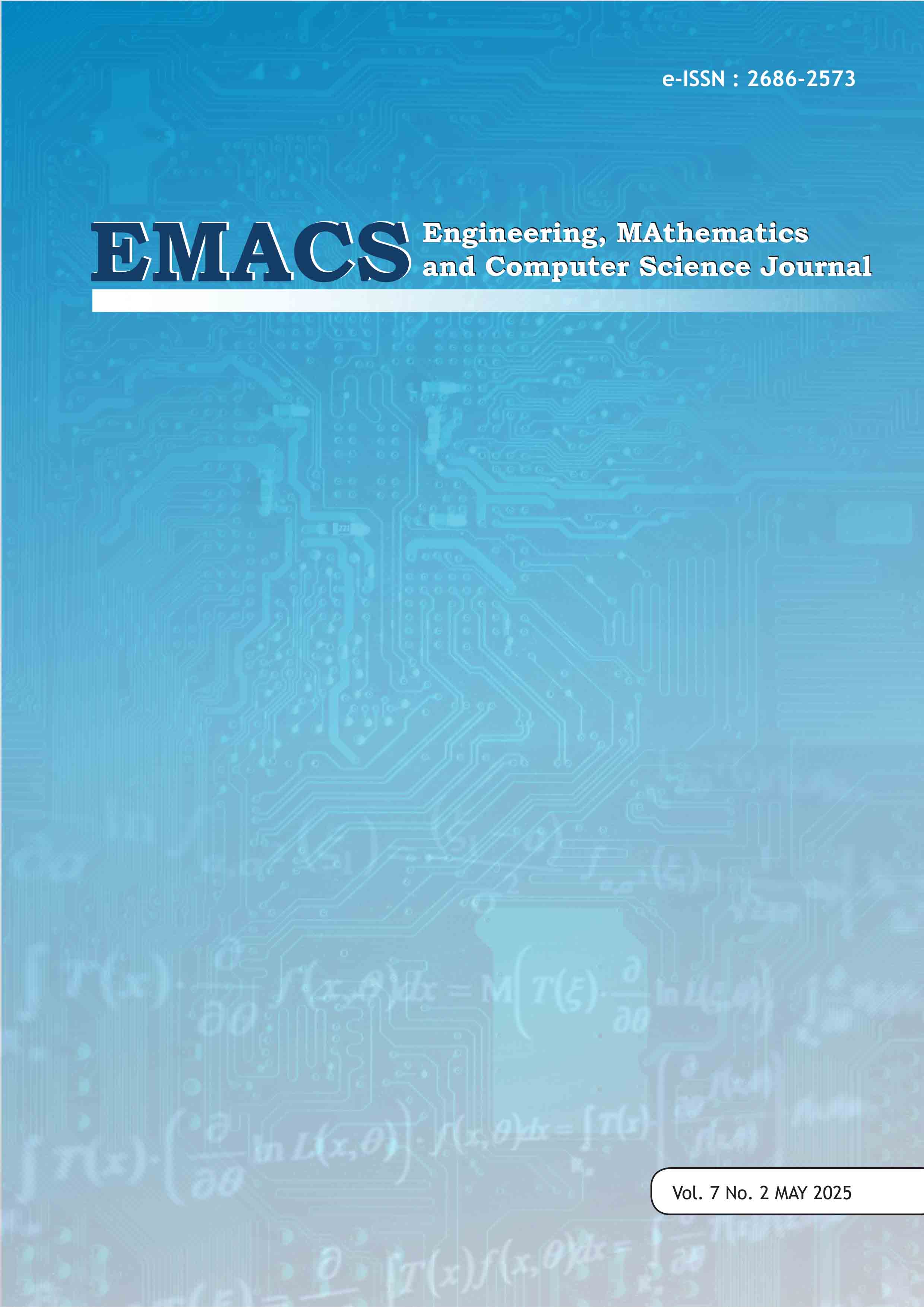A Study of Machine Learning Approach to Predict the Out performance Market of Japan’s Stock Price
DOI:
https://doi.org/10.21512/emacsjournal.v7i2.12905Keywords:
Machine Learning, Stock Performance, Financial Ratios, Logistic Regression, Market PredictionAbstract
This study employs machine learning algorithms to estimate the stock performance of Japanese companies in 2022, with a focus on examining the relationship between significant financial factors—Market Capitalization (Market Cap), Price-to-Earnings Ratio (PER), Price-to-Book Value (PBV), Return on Equity (ROE), and Debt-to-Equity Ratio (DER)—and stock performance, classified as either high-performing or low-performing. These factors are designated as independent variables. The dataset comprises 1,000 publicly listed companies in Japan and is analyzed using a logistic regression model. The dependent variable in this study is stock performance. The Akaike Information Criterion (AIC) guided model selection to optimize predictive accuracy and model complexity. The dataset was split into 70% for training and 30% for testing to ensure robust model validation. The best-performing model achieved a prediction accuracy of 62.67%, demonstrating strong sensitivity (88.83%) but weak specificity (18.75%). An AUC value of 0.6226 indicates moderate discriminatory power. The model shows good capability in detecting underperforming stocks, while its limitation lies in classifying well-performing stocks. The study suggests enhancing prediction accuracy by incorporating additional relevant variables such as macroeconomic indicators or market trends, as well as employing more complex machine learning algorithms like Random Forest or Gradient Boosting. These findings not only contribute to the literature on stock market prediction but also offer practical insights for investors in making investment decisions.
References
Abate, G., Basile, I., & Ferrari, P. (2021). The level of sustainability and mutual fund performance in Europe: An empirical analysis using ESG ratings. Corporate Social Responsibility and Environmental Management, 28(5), 1446–1455. https://doi.org/10.1002/csr.2175
Bodie, Z., Kane, A., & Marcus, A. J. (2014). Investments. https://www.mheducation.com/cover-images/Jpeg_400-high/0077861671.jpeg
Dutta, A., Bandopadhyay, G., & Sengupta, S. (2012). Prediction of stock performance in the Indian stock market using logistic regression. International Journal of Business and Information, 7(1), 105.
Damodaran, A. (2012). Investment Valuation: Tools and Techniques for Determining the Value of Any Asset. Wiley. http://people.stern.nyu.edu/adamodar/New_Home_Page/home.htm
Fischer, T., & Krauss, C. (2018). Deep learning with long short-term memory networks for financial market predictions. European Journal of Operational Research, 270(2), 654–669. https://econpapers.repec.org/article/eeeejores/v_3a270_3ay_3a2018_3ai_3a2_3ap_3a654-669.htm
García, F., Guillén, M., & Sentana, E. (2020). Metrics for financial risk assessment. Journal of Financial Economics, 136(1), 195-219. https://www.mdpi.com/2227-9091/10/2/35
Hassan, H., & Hoshino, Y. (2007). The performance impacts of stock options in Japan. Japanese Journal of Administrative Science, 20(1), 27-41.
Li, J., Wang, X., Ahmad, S., Huang, X., & Khan, Y. A. (2023). Optimization of investment strategies through machine learning. Heliyon, 9(5), e16155. https://doi.org/10.1016/j.heliyon.2023.e16155
Penman, S. H. (2013). Financial Statement Analysis and Security Valuation. McGraw-Hill Education. https://www.mheducation.com/cover-images/Jpeg_400-high/0078025311.jpeg
Prasetyo, A., & Kurniawan, A. (2023). The influence of earnings per share (EPS), price earnings ratio (PER), price to book value (PBV), and debt equity ratio (DER) on the stock return. ResearchGate. https://www.researchgate.net/publication/379165841_The_Influence_of_Earnings_Per_Share_EPS_Price_Earnings_Ratio_PER_Price_to_Book_Value_PBV_And_Debt_Equity_Ratio_DER_On_The_Stock_Return
Lento, G., & Dananjaya, Y. (2024, September). The Impact of Profitability on Stock Returns: A Comparative Analysis Between Companies With High And Low Leverage Levels. In Proceeding National Conference Business, Management, and Accounting (NCBMA) (pp. 1089-1095).
Rouf, N., Malik, M. B., Arif, T., Sharma, S., Singh, S., Aich, S., & Kim, H.-C. (2021). Stock Market Prediction Using Machine Learning Techniques: A Decade Survey on Methodologies, Recent Developments, and Future Directions. Electronics, 10(21), 2717. https://doi.org/10.3390/electronics10212717
Zaidi, M., & Amirat, A. (2016). Assessing stock performance using panel logistic regression: evidence from KSA stock market. Math. Finance Lett., 2016, Article-ID.
Zhang, D., Zhang, Z., & Wang, C. (2021). Machine learning in predicting stock market performance: A review. https://www.researchgate.net/publication/380289212_MACHINE_LEARNING_FOR_STOCK_MARKET_FORECASTING_A_REVIEW_OF_MODELS_AND_ACCURACY
Zhang, X., Li, Y., & Wang, X. (2023). Stock selection using machine learning based on financial ratios. Mathematics, 11(23), Article 4758. https://www.mdpi.com/2227-7390/11/23/4758?utm_source=chatgpt.com
Downloads
Published
How to Cite
Issue
Section
License
Copyright (c) 2025 Charissa Amadea, Karina Karina, Kanisha Addina, Keisha Adara, Asysta Pasaribu

This work is licensed under a Creative Commons Attribution-ShareAlike 4.0 International License.
Authors who publish with this journal agree to the following terms:
- Authors retain copyright and grant the journal right of first publication with the work simultaneously licensed under a Creative Commons Attribution License - Share Alike that allows others to share the work with an acknowledgment of the work's authorship and initial publication in this journal.
- Authors are able to enter into separate, additional contractual arrangements for the non-exclusive distribution of the journal's published version of the work (e.g., post it to an institutional repository or publish it in a book), with an acknowledgment of its initial publication in this journal.
- Authors are permitted and encouraged to post their work online (e.g., in institutional repositories or on their website) prior to and during the submission process, as it can lead to productive exchanges, as well as earlier and greater citation of published work.
USER RIGHTS
All articles published Open Access will be immediately and permanently free for everyone to read and download. We are continuously working with our author communities to select the best choice of license options, currently being defined for this journal as follows: Creative Commons Attribution-Share Alike (CC BY-SA)





